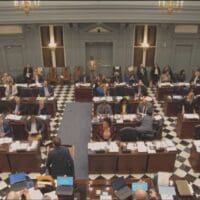

A Chinese juniper (Juniperus chinensis ‘Shimpaku’) in The Kennett Collection is among plants that will be donated to Longwood Gardens.
Longwood Gardens this week received a gift of 150 extraordinary bonsai trees and will receive a $1 million bequest to take care of the eminent Kennett Collection.
Hailing the donation as the finest private collection of bonsai in the Western World, Longwood officials said the addition raises the garden’s collection to world-class.
“These important bonsai trees, which have been so lovingly and carefully trained, will elevate Longwood’s collection to one of the most significant in the country,” said Paul B. Redman, chief executive 0fficer of Longwood Gardens. “We are extraordinarily grateful to Doug Paul for this transformative gift and the faith he shows in our bonsai program by entrusting us with these
important living works of art.”
Bonsai are ornamental trees or shrubs grown in a pot and artificially prevented from reaching normal size. They are prized as works of art for their beauty, which often contradicts what may be considered the norms of the gardening world.
Longwood, a former du Pont estate in Kennett Square, Pennsylvania, has displayed examples of its existing collection of 78, known for the diversity of flowering species and four notable trees developed by artist Yuri Yoshimura, in individual shadow-box settings that rival a display in museums.
One small plant that grew a full-size pomegranate fascinated visitors for years.
Part of the gardens’ $250 million Longwood Reimagined project is creating a new outdoor Bonsai Courtyard and the Kennett Collection will be centerpieces in that display when it opens in 2024.
Paul’s gift will come in two parts. The first is the 50 plants that will be given to Longwood over the next two years and some cash to support their maintenance.
Longwood Gardens bonsai bequest
The second is will be a bequest of 100 additional specimens and a $1 million endowment for continued care of the collection and additional acquisitions. It will include related pieces, such as the containers used for display.
Among the plants that Paul is donating are those referred to as kicho bonsai or Important Bonsai Masterpieces because of their beauty or rarity, a press release said.
“Most significantly,” the Longwood Gardens release said, “it will add important examples of rare Japanese tree species, making Longwood Gardens the leading collection of bonsai trained in Japan on public view in the United States.”
“I am delighted to give specimens from The Kennett Collection to Longwood,” Paul said. “I have spent many happy years stewarding these bonsai and sharing them with other bonsai connoisseurs at the Kokufu exhibition—the Westminster dog show of the bonsai world. I am now looking forward to a wider public getting to enjoy their beauty and splendor at Longwood.”
RELATED STORY: Longwood will spend $250 million to redo conservatory for 21st century
RELATED STORY: Light artists hopes Longwood fans find installation joyous
Paul started the Kennett Collection in 1999. It now has 1,200 specimens that have been tended by the world’s leading bonsai experts.
Many have been invited for display in the Kokufu Bonsai Exhibition and have been designated “Registered Masterpiece Bonsai” by the Nippon Bonsai Association.
“Paul has been able to do what nobody else has done in the U.S. and that is to import, maintain, and improve specimens from Japan of the highest quality,” said Peter Warren, the U.K.’s leading bonsai professional. “Once The Kennett Collection trees are situated at Longwood, it will be without doubt one of the top three collections in the U.S. All of the trees in the collection have a unique and prestigious place in bonsai history, many spanning generations.”
The first 50 trees that will arrive in the next two years include examples from many of Japan’s most famous nurseries, including the Chinsho-en nursery run by the Nakanishi family in Takamatsu as well as plants from world-renowned bonsai artists, such as Kimura Masahiko; Suzuki Shinji of Japan; and Suthin Sukosolvisit of Boston.
The gift also will include breathtaking Omono or “Very Large” bonsai, measuring three to four feet in height and weighing a few hundred pounds each.
Seven of these bonsai will go on view immediately in Longwood’s Conservatory, where they can be
seen until November 13, 2022.
They include:


A 18-inch trident maple in the root over rock style, developed by Suthin Sukosolvisit.
A trident maple (Acer buergerianum) in the root over rock style was popularized more than 100 years ago in the Nagoya area of Japan. This specimen was developed by the Boston bonsai artist Suthin Sukosolvisit, who is considered by many as the best non-Japanese trained artist in the western world. The balance and movement of the roots over and down the rock are close to ideal, and the tree has achieved a superb level of maturity with an incredibly dense canopy of well-ramified twigs and branches.


A 24-inch Japanese white pine in the root over rock style, developed by Kimura Masahiko.
A Japanese white pine (Pinus parviflora ‘Miyajima’), which was styled by the celebrated bonsai artist Kimura Masahiko. Over many years, he reshaped the branches and developed growth to complement the way the roots grip the rocks. Following the specimen’s difficult journey to the United States, Masahiko first foreign apprentice, Marco Invernizzi, returned the tree to health.


A 20-inch Japanese black pine in the upright style, initially trained by Suzuki Shinji
Japanese black pine (Pinus thunbergii), is considered one of the most important species in Japan and is revered for its vigor and longevity. This specimen, which is 20 inches tall and in the upright style, was initially trained under the care of the internationally renowned Suzuki Shinji.


A 30-inch Satsuki hybrid azalea in the informal upright style, developed by Kunio Kobayashi
A Satsuki hybrid azalea (Rhododendron ‘kinsai’) of the kinsai variety, which is known for its flowers’ resemblance to a firecracker—a distinctive red flower with tassels. This superb specimen, originally from the garden of Kunio Kobayashi founder of the Shunkaen Bonsai Museum in Japan, has been trained in the informal upright style and is notable for its distinctive branching structure and muscular trunk with sinuous veins.
The majority of the 50 bonsai from The Kennett Collection gift will go on long-term view during the grand opening of Longwood Reimagined in late 2024.
The new outdoor Bonsai Courtyard will be built alongside the new West Conservatory. Hedges and charred wood walls will create an intimate, gallery-like space, where dozens of bonsai will be displayed on free-standing pedestals against dark backdrops that highlight their forms, foliage, and seasonal bloom, according to Longwood.
Longwood Gardens’ own Bonsai Collection began in 1959, five years after founder Pierre S. du Pont’s death. Inspired by a Continuing Education program led by renowned bonsai artist Yuji Yoshimura, Longwood leadership decided to begin to build a collection.
Starting with 13 trees purchased from Yoshimura, the collection has now grown to 78 trees with 50 species represented. Longwood’s collection is notable for the prominence of flora from its local landscape. The oldest trees in the collection have been in training for more than 110 years.
Nine styles are represented, including upright, informal upright, cascade, raft, forest, root over rock, broom, slant and literati.
Longwood also has tropical trees, eight of which were added in 2021 and include notable examples of a Tiger Bark Fig, Ficus retusa, with aerial roots; a Vietnamese Blue Bell Tree,
Trifidacanthus unifoliolatus, with fragrant purple flowers; and a Desert Rose, Adenium obesum, an African succulent with pink bi-colored flowers.
The collection also has a small, but significant group of eight Japanese imports.


Betsy Price is a Wilmington freelance writer who has 40 years of experience.
Share this Post








